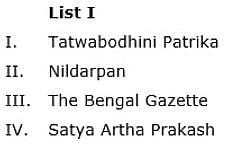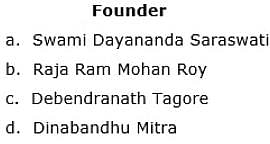APSET Paper 2 Mock Test - 1 (History) - AP TET MCQ
30 Questions MCQ Test APSET Mock Test Series 2025 - APSET Paper 2 Mock Test - 1 (History)
Analyze the contrasting roles of the Surat Split and the Lucknow Pact in the Congress's history.
Based on the passage, can it be argued that the Congress's success in achieving independence primarily rested on its
| 1 Crore+ students have signed up on EduRev. Have you? Download the App |
The passage invites us to interpret the Indian National Congress as
Which of the following statement/s is/are not correct about Vijayanagara empire?
Choose the correct statements.
1) In 1858 Lord Canning sent forth the royal proclamation in a grand Darbar at Delhi.
2) It was then proclaimed that all treaties and engagements of East India Company with princely states would be maintained and honoured.
3) The document was called “Magnacarta of the People of India”.
Arrange the following events in their chronological order and select the correct answer from the codes given below:
A. Hunter Commission
B. Saddler Commission
C. Wood's Despatch
D. Sargent Plan
Consider the following statements:
Assertion(A):- In sharp contrast to Egypt and Mesopotamia, the Harappan culture was poor in the artistic works made of stone.
Reason(R):- We do not come across any massive work of art in stone.
With reference to Dhrupad, one of the major traditions of India that has been kept alive for centuries, which of the following statements are correct?
1) Dhrupad originated and developed in the Rajput kingdoms during the Mughal period.
2) Dhrupad is primarily a devotional and spiritual music.
3) Dhrupad Alap uses Sanskrit syllables from Mantras.
Select the correct answer using the codes given below :
Consider the following statements
1). Wood's Despatch laid emphasis on higher education and neglected primary education
2). Macaulayian system was outcome of Orinetalist-Anglicist controversy
Which of the above statement(s) is/are incorrect?
In 1889, __________ established the Mukti Mission, a refuge for young widows who had been deserted and abused by their families.
Match the following.
List I
I. Sandhya
II. Kriti
III. Kranti
IV. Yugantar
List II
a. Santosh Singh
b. S.S. Mirzakar and Joglekar
c. Brahmobandhab Upadhyay
d.Barindra Kumar Ghosh, Abhinash Bhattachary and Bhupendranath Dutt.
What was the ratio of the Indian sepoys to the Europeans in the British Indian Army on the eve of the outbreak of the Revolt of 1857?
"The British empire is rotten to the core, corrupt in every direction and tyrannical and mean". This statement was made by-
According to historical findings, who discovered the Arthashastra in 1905?
Among the given options, which of the following is the correct match for Prarthana Samaj, Young India, Lokhitvadi, Satyashodhak Samaj and Rehnumai Mazdayasan Sabha, respectively?
With reference to the system of ‘Subsidiary Aliances’, consider the following statements.
1) Under this system, the ruler of the allying Indian state was to be provided with the British defence forces only when required.
2) The ruler also sometimes ceded part of his territory instead of paying annual subsidy.
3) The ruler could employ any European in his service at his court.
Choose the incorrect answer
Who was the author of the play ‘Nil Darpan’?
French East India Company was constructed during the reign of-
|
60 tests
|



















